Compact On-Chip Metalens-Assisted Optical Switch Enabling Efficient and Scalable Beam Switching
Abstract
:1. Introduction
2. Design of the Proposed Optical Switch Incorporating an On-Chip Metalens
2.1. Configuration of the Proposed Optical Switch
2.2. Design of the Phase Modulator Array
2.3. Design of On-Chip Metalens
3. Results and Discussion
4. Conclusions
Author Contributions
Funding
Institutional Review Board Statement
Informed Consent Statement
Data Availability Statement
Conflicts of Interest
Appendix A

| WMMI | LMMI | Wi | Wo | Ltaper | Λtaper |
|---|---|---|---|---|---|
| 24 µm | 65.5 µm | 2.0 µm | 1.3 µm | 10 µm | 1.51 µm |
Appendix B

Appendix C
References
- Wang, K.; Dong, X.; Köhler, M.H.; Kienle, P.; Bian, Q.; Jakobi, M.; Koch, A.W. Advances in optical fiber sensors based on multimode interference (MMI): A review. IEEE Sens. J. 2020, 21, 132–142. [Google Scholar] [CrossRef]
- Chen, L.; Chen, Y.K. Compact, low-loss and low-power 8 × 8 broadband silicon optical switch. Opt. Express 2012, 20, 18977–18985. [Google Scholar] [CrossRef] [PubMed]
- Duan, F.; Chen, K.; Chen, D.; Yu, Y. Low-power and high-speed 2 × 2 thermo-optic MMI-MZI switch with suspended phase arms and heater-on-slab structure. Opt. Lett. 2021, 46, 234–237. [Google Scholar] [CrossRef] [PubMed]
- Gao, Y.; Sun, X.; Li, P.; Zhang, D. Polymer mode selecting switch based on cascaded MMI couplers. IEEE Photonics Technol. Lett. 2021, 33, 147–150. [Google Scholar] [CrossRef]
- Cheng, R.; Zhang, D.; Wang, J.; Wang, C.; Gao, F.; Sun, X.; Shi, Z.; Cui, Z.; Chen, C. Fluorinated photopolymer cascaded MMI-based integrated optical waveguide switching matrix with encoding functions. Opt. Express 2019, 27, 12883–12898. [Google Scholar] [CrossRef] [PubMed]
- Lu, L.; Zhou, L.; Li, Z.; Li, D.; Zhao, S.; Li, X.; Chen, J. 4 × 4 silicon optical switches based on double-ring-assisted Mach–Zehnder interferometers. IEEE Photonics Technol. Lett. 2015, 27, 2457–2460. [Google Scholar] [CrossRef]
- Han, Y.T.; Shin, J.U.; Park, S.H.; Han, S.P.; Baek, Y.; Lee, C.H.; Noh, Y.O.; Lee, H.J.; Park, H.H. Fabrication of 10-channel polymer thermo-optic digital optical switch array. IEEE Photonics Technol. Lett. 2009, 21, 1556–1558. [Google Scholar] [CrossRef]
- Watts, M.R.; Sun, J.; DeRose, C.; Trotter, D.C.; Young, R.W.; Nielson, G.N. Adiabatic thermo-optic Mach–Zehnder switch. Opt. Lett. 2013, 38, 733–735. [Google Scholar] [CrossRef]
- Lian, T.; Xie, Y.; Yu, Q.; Sun, S.; Sun, X.; Wang, X.; Zhang, D. Mode-independent optical switch based on graphene-polymer hybrid waveguides. Photonics 2023, 10, 1372. [Google Scholar] [CrossRef]
- Zhou, J.; Gallion, P. Operation principles for optical switches based on two multimode interference couplers. J. Lightw. Technol. 2011, 30, 15–21. [Google Scholar] [CrossRef]
- Brunetti, G.; Marocco, G.; Di Benedetto, A.; Giorgio, A.; Armenise, M.N.; Ciminelli, C. Design of a large bandwidth 2 × 2 interferometric switching cell based on a sub-wavelength grating. J. Opt. 2021, 23, 085801. [Google Scholar] [CrossRef]
- Gobet, M.; Herbst, P.; Baroni, P.; Marxer, C. Applications of optical MEMS for space missions. In Proceedings of the 6th ESA Round Table on Micro/Nano Technologies for Space, Noordwijk, The Netherlands, 8–12 October 2007; pp. 13–17. Available online: https://escies.org/webdocument/showArticle?id=766&groupid=6 (accessed on 1 June 2024).
- Chung, S.; Abediasl, H.; Hashemi, H. A monolithically integrated large-scale optical phased array in silicon-on-insulator CMOS. IEEE J. Solid-State Circuits 2018, 53, 275–296. [Google Scholar] [CrossRef]
- Im, C.-S.; Kim, S.-M.; Lee, K.-P.; Ju, S.-H.; Hong, J.-H.; Yoon, S.-W.; Kim, T.; Lee, E.-S.; Bhandari, B.; Zhou, C.; et al. Hybrid integrated silicon nitride–polymer optical phased array for efficient light detection and ranging. J. Lightw. Technol. 2021, 39, 4402–4409. [Google Scholar] [CrossRef]
- Bhandari, B.; Wang, C.; Gwon, J.-Y.; Heo, J.-M.; Ko, S.-Y.; Oh, M.-C.; Lee, S.-S. Dispersive silicon–nitride optical phased array incorporating arrayed waveguide delay lines for passive line beam scanning. Sci. Rep. 2022, 12, 18759. [Google Scholar] [CrossRef] [PubMed]
- Wang, P.; Luo, G.; Xu, Y.; Li, Y.; Su, Y.; Ma, J.; Wang, R.; Yang, Z.; Zhou, X.; Zhang, Y.; et al. Design and fabrication of a SiN-Si dual-layer optical phased array chip. Photonics Res. 2020, 8, 912–919. [Google Scholar] [CrossRef]
- Kim, Y.; Yoon, H.; You, J.-B.; Kim, M.; Park, H.-H. Wide-angle beam-steering using an optical phased array with non-uniform-width waveguide radiators. Photonics 2020, 7, 56. [Google Scholar] [CrossRef]
- Im, C.-S.; Bhandari, B.; Lee, K.-P.; Kim, S.-M.; Oh, M.-C.; Lee, S.-S. Silicon nitride optical phased array based on a grating antenna enabling wavelength-tuned beam steering. Opt. Express 2020, 28, 3270–3279. [Google Scholar] [CrossRef] [PubMed]
- Hutchison, D.N.; Sun, J.; Doylend, J.K.; Kumar, R.; Heck, J.; Kim, W.; Phare, C.T.; Feshali, A.; Rong, H. High-resolution aliasing-free optical beam steering. Optica 2016, 3, 887–890. [Google Scholar] [CrossRef]
- Shin, M.C.; Mohanty, A.; Watson, K.; Bhatt, G.R.; Phare, C.T.; Miller, S.A.; Zadka, M.; Lee, B.S.; Ji, X.; Datta, I.; et al. Chip-scale blue light phased array. Opt. Lett. 2020, 45, 1934–1937. [Google Scholar] [CrossRef]
- Dostart, N.; Zhang, B.; Khilo, A.; Brand, M.; Al Qubaisi, K.; Onural, D.; Feldkhun, D.; Wagner, K.H.; Popović, M.A. Serpentine optical phased arrays for scalable integrated photonic lidar beam steering. Optica 2020, 7, 726–733. [Google Scholar] [CrossRef]
- Alemany, R.; Muñoz, P.; Pastor, D.; Domínguez, C. Thermo-optic phase tuners analysis and design for process modules on a silicon nitride platform. Photonics 2021, 8, 496. [Google Scholar] [CrossRef]
- Heck, M.J. Highly integrated optical phased arrays: Photonic integrated circuits for optical beam shaping and beam steering. Nanophotonics 2017, 6, 93–107. [Google Scholar] [CrossRef]
- Chen, S.; Huang, J.; Yin, S.; Milosevic, M.M.; Pi, H.; Yan, J.; Chong, H.M.H.; Fang, X. Metasurfaces integrated with a single-mode waveguide array for off-chip wavefront shaping. Opt. Express 2023, 31, 15876–15887. [Google Scholar] [CrossRef]
- Li, H.; Lee, W.-B.; Zhou, C.; Choi, D.-Y.; Lee, S.-S. Flat retroreflector based on a metasurface doublet enabling reliable and angle-tolerant free-space optical link. Adv. Opt. Mater. 2021, 9, 2100796. [Google Scholar] [CrossRef]
- Chen, C.; Qi, W.; Yu, Y.; Zhang, X. On-chip optical spatial-domain integrator based on Fourier optics and metasurface. Nanophotonics 2021, 10, 2481–2486. [Google Scholar] [CrossRef]
- Wang, Z.; Li, T.; Soman, A.; Mao, D.; Kananen, T.; Gu, T. On-chip wavefront shaping with dielectric metasurface. Nat. Commun. 2019, 10, 3547. [Google Scholar] [CrossRef] [PubMed]
- Rajabalipanah, H.; Abdolali, A.; Iqbal, S.; Zhang, L.; Cui, T.J. Analog signal processing through space-time digital metasurfaces. Nanophotonics 2011, 10, 1753–1764. [Google Scholar] [CrossRef]
- Yang, R.; Shi, Y.; Dai, C.; Wan, C.; Wan, S.; Li, Z. On-chip metalenses based on one-dimensional gradient trench in the broadband visible. Opt. Lett. 2020, 45, 5640–5643. [Google Scholar] [CrossRef]
- Alquliah, A.; Elkabbash, M.; Cheng, J.; Verma, G.; Saraj, C.S.; Li, W.; Guo, C. Reconfigurable metasurface-based 1 × 2 waveguide switch. Photonics Res. 2021, 9, 2104–2115. [Google Scholar] [CrossRef]
- Li, H.; Zhou, C.; Lee, W.-B.; Choi, D.Y.; Lee, S.-S. Flat telescope based on an all-dielectric metasurface doublet enabling polarization-controllable enhanced beam steering. Nanophotonics 2022, 11, 405–413. [Google Scholar] [CrossRef]
- Xie, Z.; Lei, T.; Li, F.; Qiu, H.; Zhang, Z.; Wang, H.; Min, C.; Du, L.; Li, Z.; Yuan, X. Ultra-broadband on-chip twisted light emitter for optical communications. Light Sci. Appl. 2018, 7, 18001. [Google Scholar] [CrossRef] [PubMed]
- Meng, Y.; Liu, Z.; Xie, Z.; Wang, R.; Qi, T.; Hu, F.; Kim, H.; Xiao, Q.; Fu, X.; Wu, Q.; et al. Versatile on-chip light coupling and (de) multiplexing from arbitrary polarizations to controlled waveguide modes using an integrated dielectric metasurface. Photonics Res. 2020, 8, 564–576. [Google Scholar] [CrossRef]
- Hsieh, P.Y.; Fang, S.L.; Lin, Y.S.; Huang, W.H.; Shieh, J.M.; Yu, P.; Chang, Y.C. Integrated metasurfaces on silicon photonics for emission shaping and holographic projection. Nanophotonics 2022, 11, 4687–4695. [Google Scholar] [CrossRef]
- Huang, Z.; Zheng, Y.; Li, J.; Cheng, Y.; Wang, J.; Zhou, Z.K.; Chen, L. High-resolution metalens imaging polarimetry. Nano Lett. 2023, 23, 10991–10997. [Google Scholar] [CrossRef]
- Li, J.; Liu, W.; Xu, H.; Huang, Z.; Wang, J.; Wen, J.; Yang, J.; Guan, J.; Wang, S.; Alù, A.; et al. An RGB-achromatic aplanatic metalens. Laser Photonics Rev. 2024, 18, 2300729. [Google Scholar] [CrossRef]
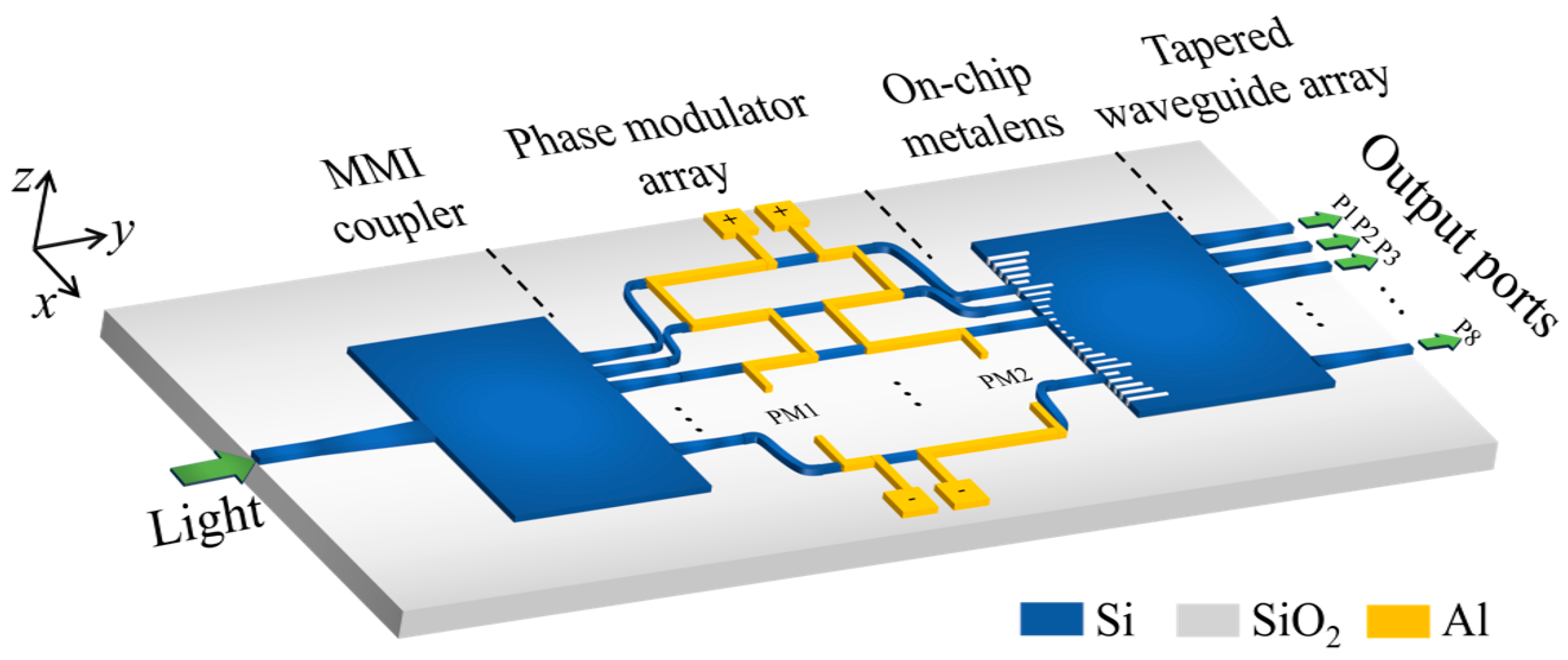

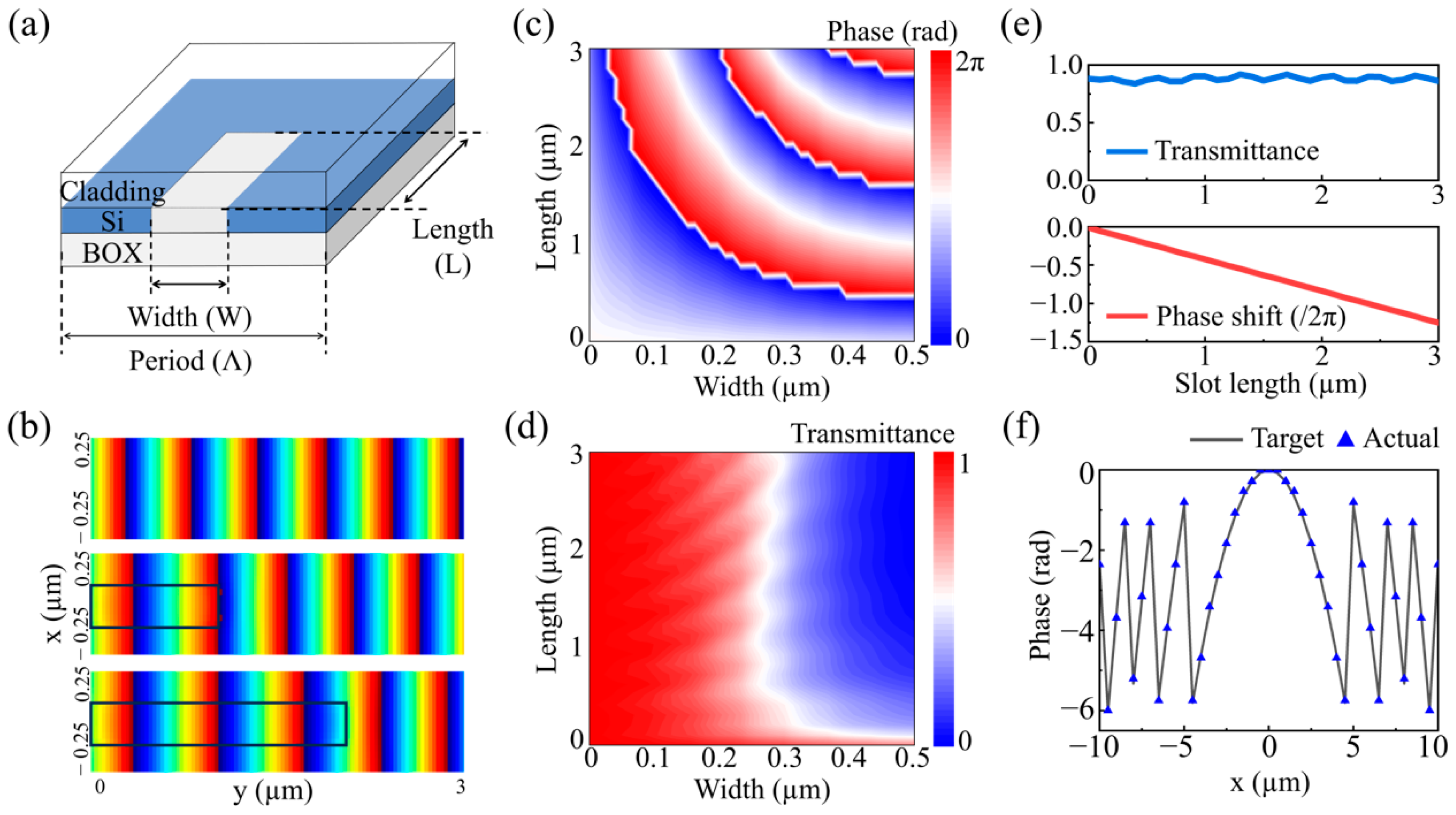

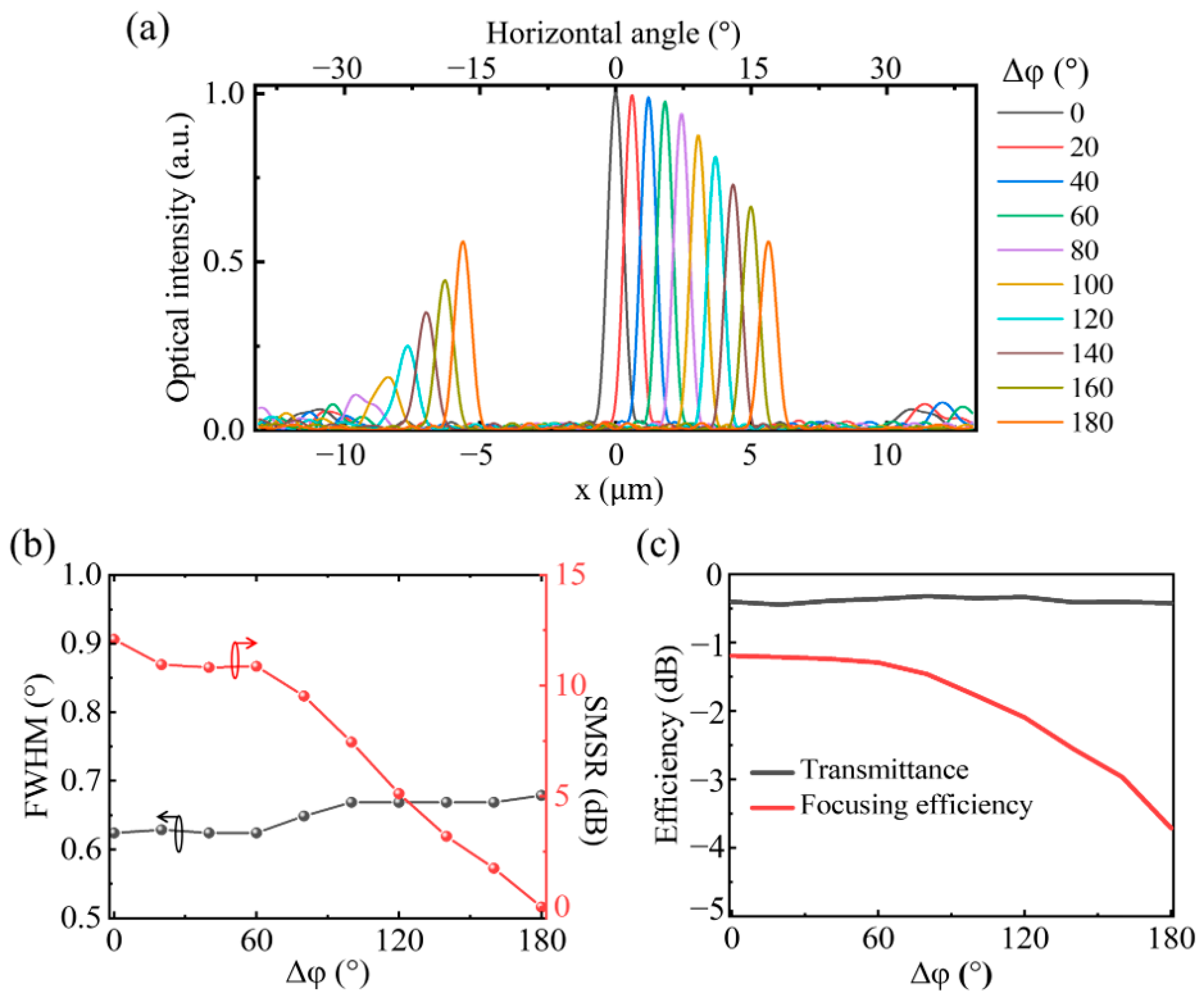
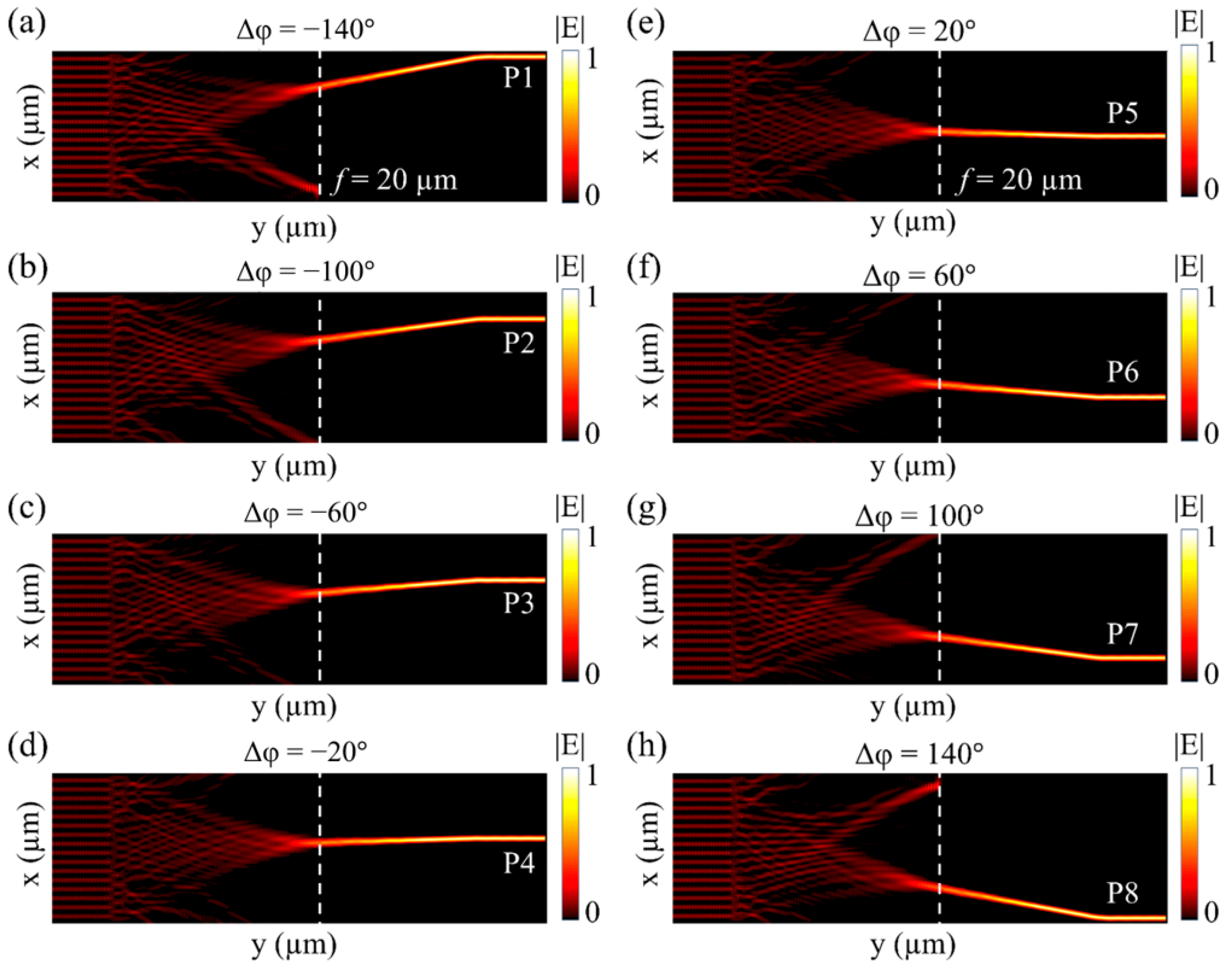

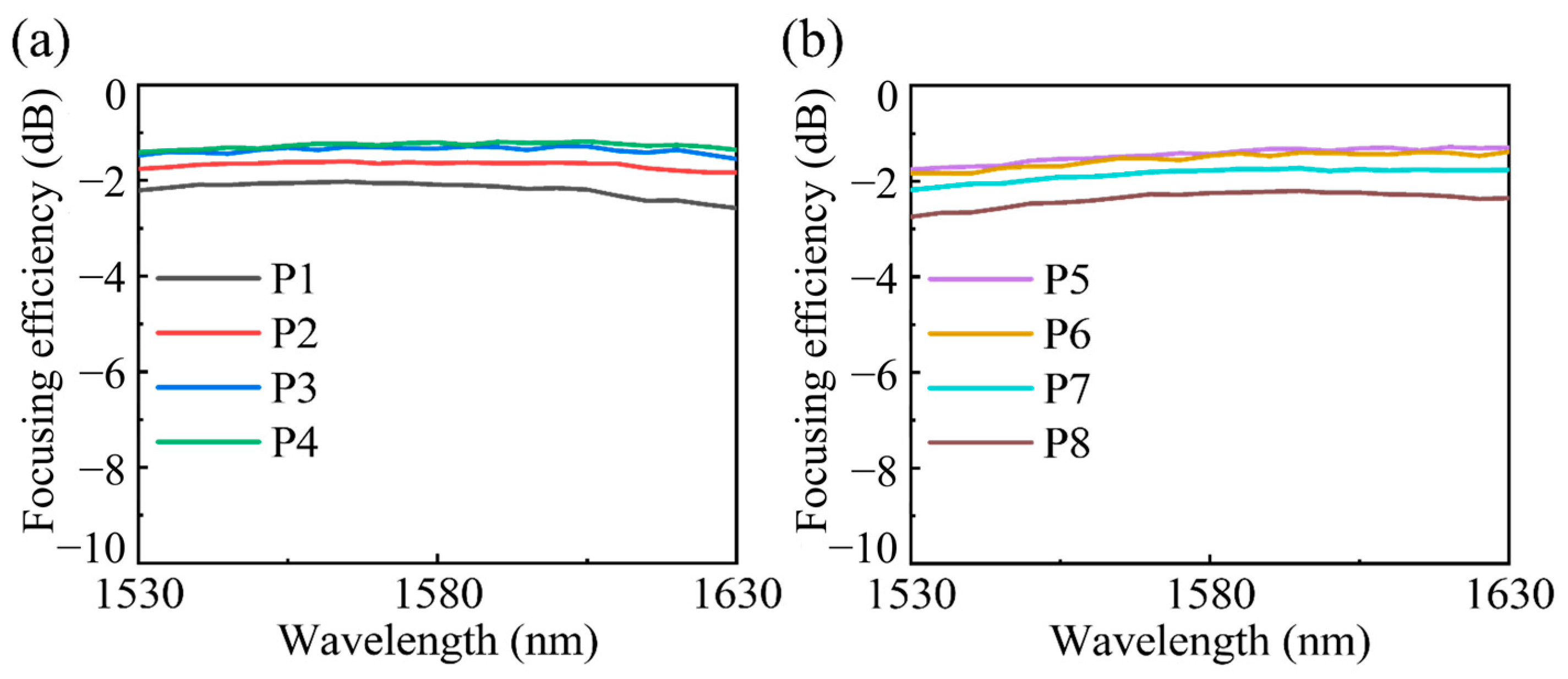
| Type | Nout | Footprint | IL | Power Consumption | Reference |
|---|---|---|---|---|---|
| MMI-MZI | 8 | 8 × 8 mm2 | 4 dB | 70 mW | [2] |
| Ring resonator | 4 | 3.4 × 1.6 mm2 | ~5 dB | 22.37 mW | [6] |
| Y-branch | 10 | 15 × 8 mm2 | 1.35 dB | 50 mW | [7] |
| SWG-assisted | 8 | 1.62 × 0.6 mm2 | 15 dB | 276 mW | [11] |
| Metalens-assisted | 8 | 1.1 × 0.8 mm2 | 2.6 dB | 45.3 mW | This work |
| f (µm) | Nch = 8 | Nch = 16 | Nch = 32 | |||||||||
|---|---|---|---|---|---|---|---|---|---|---|---|---|
| FWHM (µm) | FW (µm) | x_max (µm) | Nout | FWHM (µm) | FW (µm) | x_max (µm) | Nout | FWHM (µm) | FW (µm) | x_max (µm) | Nout | |
| 10 | 0.74 | 1.54 | 4.9 | 5 | 0.42 | 0.87 | 4.9 | 9 | 0.23 | 0.52 | 4.9 | 14 |
| 20 | 1.38 | 2.47 | 7.2 | 5 | 0.62 | 1.10 | 7.2 | 8 | 0.42 | 0.75 | 7.2 | 16 |
| 30 | 2.31 | 4.93 | 10.3 | 4 | 1.16 | 2.45 | 10.3 | 8 | 0.77 | 1.63 | 10.3 | 12 |
Disclaimer/Publisher’s Note: The statements, opinions and data contained in all publications are solely those of the individual author(s) and contributor(s) and not of MDPI and/or the editor(s). MDPI and/or the editor(s) disclaim responsibility for any injury to people or property resulting from any ideas, methods, instructions or products referred to in the content. |
© 2024 by the authors. Licensee MDPI, Basel, Switzerland. This article is an open access article distributed under the terms and conditions of the Creative Commons Attribution (CC BY) license (https://creativecommons.org/licenses/by/4.0/).
Share and Cite
Wang, C.; Li, H.; Li, J.; Lee, S.-S. Compact On-Chip Metalens-Assisted Optical Switch Enabling Efficient and Scalable Beam Switching. Photonics 2024, 11, 611. https://doi.org/10.3390/photonics11070611
Wang C, Li H, Li J, Lee S-S. Compact On-Chip Metalens-Assisted Optical Switch Enabling Efficient and Scalable Beam Switching. Photonics. 2024; 11(7):611. https://doi.org/10.3390/photonics11070611
Chicago/Turabian StyleWang, Chenxi, Hongliang Li, Jinke Li, and Sang-Shin Lee. 2024. "Compact On-Chip Metalens-Assisted Optical Switch Enabling Efficient and Scalable Beam Switching" Photonics 11, no. 7: 611. https://doi.org/10.3390/photonics11070611





